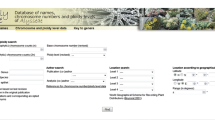Abstract
Chromosome numbers and karyomorphological characters have been investigated inPamphilia andStyrax (Styracaceae). Counted for the first time in the genus, two species ofPamphilia were found to have 2n = 16. The twoStyrax spp. investigated share withPamphilia the same chromosome number, a peculiar condensation behaviour of the chromosomes (Fig. 1a–c) and the same type of semi-reticulate interphase nucleus, results which indicate a close relationship of the two genera. The base number inStyracaceae is probably x = 8 (2n = 2x = 16) with stabilized triploids inHalesia andPterostyrax (2n = 3x = 24). A preliminary comparison withSapotaceae andEbenaceae does not allow a general karyological characterisation of the orderEbenales.
Similar content being viewed by others
References
Dahlgren, R., 1983: General aspects of angiosperm evolution and macrosystematics. — InEhrendorfer, F., Dahlgren, R., (Eds.): New evidence of relationships and modern systems of classifications of the angiosperms. — Nordic J. Bot.3: 119–149.
De Candolle, A., 1844:Styracaceae. — InDe Candolle, A., (Ed.): Prodromus systematis naturalis regni vegetabilis8: 244–272. — Paris: Fortin, Masson et Soc.
Fedorov, An. A., (Ed.), 1969: Chromosome numbers of flowering plants. — Leningrad: Izdatel'stvo “Nauka”.
Goldblatt, P., (Ed.), 1981, 1982, 1985, 1988: Index to plant chromosome numbers 1975–1978, 1979–1981, 1982–1983 and 1984–1985. — Missouri Botanical Garden.
Guerra, M., 1983: O uso de Giemsa na citogenética vegetal—comparação entre a coloração simples e o bandeamento. — Ciência e Cultura35: 190–193.
Guervin, C., 1961: Contribution à l'étude cytotaxonomique des Sapindacées et caryologique des Mélianthacées et des Didiéracées. — Rev. Cyt. Biol. Vég.23: 49–86.
Hemmer, W., Morawetz, W., 1990: Karyological differentiation inSapindaceae with special reference toSerjania andCardiospermum. — Bot. Acta103: 372–383.
Miers, J., 1851–1861: Contributions to botany, iconographic and descriptive, detailing the characters of plants that are either new or imperfectly described; to which are added remarks on their affinities. 1. — London, Edinburgh: Williams and Norgate.
Moore, R. J., (Ed.), 1973, 1974, 1977: Index to plant chromosome numbers for 1967–1971, 1972, 1973–1974. — Regnum Veg.90, 91, 96.
Morawetz, W., 1986: Remarks on karyological differentiation patterns in tropical woody plants. — Pl. Syst. Evol.152: 49–100.
Perkins, J., 1907:Styracaceae. — InEngler, A., (Ed.): Das Pflanzenreich4, 241. — Leipzig: Engelmann.
White, F., Vosa, C. G., 1980: The chromosome cytology of AfricanEbenaceae with special reference to polyploidy. — Bol. Soc. Brot., Sér. 2,53: 275–297.
Author information
Authors and Affiliations
Rights and permissions
About this article
Cite this article
Morawetz, W. The karyology of some neotropicalStyracaceae . Pl Syst Evol 177, 111–115 (1991). https://doi.org/10.1007/BF00937831
Received:
Revised:
Accepted:
Issue Date:
DOI: https://doi.org/10.1007/BF00937831




